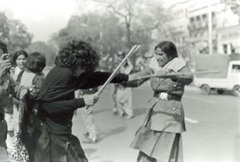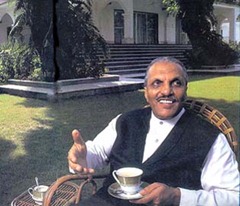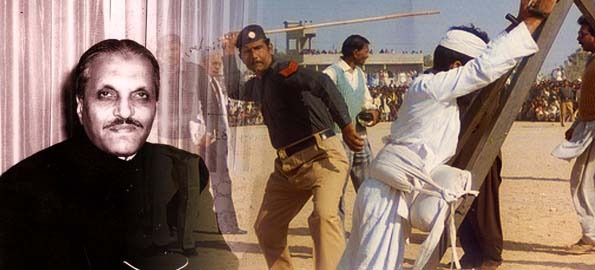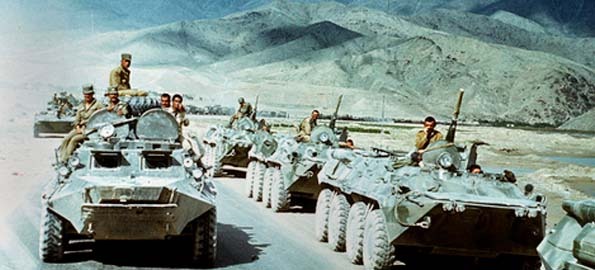“General Zia singled out Ahmadis in an open and vicious hate campaign of persecution. He and members of his administration made numerous public speeches urging Pakistanis to seek out, expose and even to kill Ahmadis.”
In 1977, Gen Mohammed Zia ul Haq usurped the constitution of Pakistan and enacted Operation Fair Play by seizing power in Pakistan. He declared martial law and imprisoned the democratically elected Prime Minister Zulfiqar Ali Bhutto and in the first of many lies and broken promises declared that his only desire was to facilitate elections in 90 days, after which he faithfully promised he would step down. Ignoring world public opinion and despite the wishes of the citizens of Pakistan he remained entrenched in power and consolidated his brutal dictatorship over the coming years. Zia would have remained a hated peripheral figure had fate not intervened following the Soviet Union’s invasion of Afghanistan in 1979. This event rapidly propelled Zia from world pariah status to center stage as he was lauded as the West’s bulwark and friend against the spread of communism.
The change in fortune for the Zia regime meant that he felt emboldened to enact a series of draconian laws that conformed to his extremist interpretation of Islam. Following a farcical trial Bhutto was sentenced to death, and Pakistan entered a new dark age of oppression and obscurantism. The Hadood Ordinance led to the imposition of a draconian penal code that legislated amputation, flogging and stoning for a wide series of offences. Rules of evidence and the punishment of adultery & rape were slanted against women, making it virtually impossible for a woman to prove an allegation of rape.
By 1984 the Zia regime was comfortable in power and whilst it continued its cooperation in the “jihad” against the Soviet Union, the West was largely happy to turn a blind eye to the excesses and repression of the Zia regime within Pakistan. It was at this time that Zia felt emboldened enough to turn on his next target-the Ahmadis of Pakistan.
Zia enacted Ordinace XX in April 1984, which was a set of laws and regulations that placed serious and draconian curbs on Ahmadis in the observance of their faith and their ability to lead their lives as citizens of Pakistan equal before the law. Ahmadis who observed all the articles of faith of their fellow Muslims were prevented by legal sanction from calling out the Adhan, referring to their place of worship as mosques, or using the Islamic salutation “Assalamo-a-laikum”. The additional prohibition that forbade Ahmadis from “posing as Muslims” was open to interpretation and application by overzealous and extremist mullah’s and government officials alike. Hundreds of Ahmadis were charged, arrested as the extremists realised that they had been given carte blanche to attack Ahmadis with impunity. In many parts of Pakistan Ahmadis were simply targeted and murdered for their beliefs. Zia felt able to send messages of solidarity to the London conference of the Khatm-e- Nabuwwat Conference in which he promised that the government of Pakistan would do all that it could do to “stamp out the cancer of Ahmadiyyat”, he further declared that he wanted to carry out the “Final solution of the Ahmadiyya question” .
Against this backdrop and climate of fear a new and pernicious campaign was launched by the Mullahs with the active connivance and encouragement of the government of Zia. Ahmadi mosques were targeted and baying mobs of extremists attacked mosques, to either destroy them brick by brick or to deface the mosque by erasing the inscription of the Kalima engraved on the walls of the mosque. Mullahs incited mobs into frenzy and whilst being provided protection by local police and members of the local authority would descend upon Ahmadi mosques and besiege the mosque and leave only after defacing and vandalising the mosque. In all such cases Ahmadis on the scene were beaten, tortured and in some tragic cases murdered on the spot. All of this happening as members of the local police and local authority looked on with indifference. There was little doubt that this campaign was officially inspired and had the approval and imprimatur of Zia ul Haq himself. Leading Human Rights Advocate Karen Parker states that:
“General Zia singled out Ahmadis in an open and vicious hate campaign of persecution. He and members of his administration made numerous public speeches urging Pakistanis to seek out, expose and even to kill Ahmadis. One such speech was broadcast on television when I was in Pakistan: in that broadcast one of Zia’s Ministers urged Pakistanis that it was their sacred duty to eliminate Ahmadis. On May 5, 1986, I had a meeting with General Zia at which he declared “Ahmadis are heretics and they offend me. I have a sacred duty to Allah to rid Pakistan of these impostors. I intend to drive them out.” At the same meeting, in discussion the United Nations Sub-Commission resolution 1985/21, General Zia told me “Ordinance XX may violate human rights but I don’t care.”
 Against this backdrop of carnage and a deliberate campaign to destroy the Ahmadiyya community, its members remained peaceful. But the daily attacks upon mosques and individual Ahmadis was taking its toll. The attacks were gaining momentum and the extremists and Mullahs were emboldened at the total impunity they enjoyed. It was at this point that fate intervened.
Against this backdrop of carnage and a deliberate campaign to destroy the Ahmadiyya community, its members remained peaceful. But the daily attacks upon mosques and individual Ahmadis was taking its toll. The attacks were gaining momentum and the extremists and Mullahs were emboldened at the total impunity they enjoyed. It was at this point that fate intervened.
The Ahmadi mosque in Sahiwal was targeted by students of a religious madrassah who were whipped into a frenzy of hate and encouraged to attack the mosque to kill all the Ahmadis and deface and remove the Kalima Tayyaba inscribed on the walls of the Ahmadi mosque. The mob descended upon the mosque on October the 26th 1984 just before Fajr prayers. The cowardly mob intended to storm into the mosque and attack the occupants. At the time, the mosque was occupied and protected by a single Ahmadi custodian Rana Naeem ud Din Ahmad. As Rana Sahib woke to the sounds of the mob he knew the fate that awaited him, but far more importantly he knew the fate of the mosque and in particular the fate of the Kalima Tayaba, that most iconic and sacred profession of faith that all Muslims have held dear since the time of the Holy Prophet himself. The Holy Prophet himself had declared that the profession of the Kalima Tayyaba was sufficient for one to accepted as a Muslim. Yet on this October day the so called defenders of the Kalima (Zia’s Mullah’s) were about to commit sacrilege by defacing that very same inscription. Only on this day, Rana Naeem ud Din Ahmad a simple mild mannered Ahmadi had decided to stand tall and decided that he would not allow his Kalima Tayyaba to be defaced, regardless of the consequences to his own life.
As the mob gathered outside the mosque Rana Sahib knew he was surrounded and that he had no way of escaping, even had he wanted to. He called out to the mob, warning them that he had no intention of allowing them forcible entry into the mosque, and that he was armed with a shotgun. Regardless, the mob surged forward and stormed into the courtyard of the mosque. Rana Sahib repeatedly warned the mob not to advance or carry out its threat to deface the Kalima. Despite repeated warnings the mob surged and placed ladders against the walls of the mosque and began to deface the Kalima Tayyaba from the walls of the mosque. At that point Rana Sahib gave his final warning and fired from his shotgun at those defacing the Kalima from the walls. The mob retreated in disarray and fled in panic from the confines of the mosque. Rana Sahib made no attempt to flee himself but calmly placed his shotgun on the ground beside him and awaited the arrival of the authorities.
Rana Sahib was arrested along with 11 other Ahmadis most of whom were not even present at the mosque, including the Murabbi of Sahiwal Mohammed Ilyas Munir who was himself the son of a missionary serving in West Africa. The 11 Ahmadis were interrogated and tortured by their captors for many months and were all charged, and sent to appear before a special military tribunal.
 Eight months later in October 1985, before a special military tribunal sentences were handed out. Death sentences were handed down to Mohammad Ilyas Munir, Ahmadiyya missionary and Rana Naeem-uddin Ahmad, custodian of Sahiwal Mosque. Four other Ahmadis were sentenced to imprisonment of 7 years each. The sentence of the tribunal were sent to General Ghulam Jilani Khan (Governor of Punjab) for ratification. General Jilani felt that there was a clear miscarriage of justice as Rana Naeem Sahib was clearly acting in self-defence and none of the other accused had been at the scene. Gen Jilani decided to raise the matter when Zia next came to Lahore. Eventually Gen Jilani explained his doubts to Zia and asked him for his instructions. Zia contemptuously shrugged his shoulders and barked “Hang them”.
Eight months later in October 1985, before a special military tribunal sentences were handed out. Death sentences were handed down to Mohammad Ilyas Munir, Ahmadiyya missionary and Rana Naeem-uddin Ahmad, custodian of Sahiwal Mosque. Four other Ahmadis were sentenced to imprisonment of 7 years each. The sentence of the tribunal were sent to General Ghulam Jilani Khan (Governor of Punjab) for ratification. General Jilani felt that there was a clear miscarriage of justice as Rana Naeem Sahib was clearly acting in self-defence and none of the other accused had been at the scene. Gen Jilani decided to raise the matter when Zia next came to Lahore. Eventually Gen Jilani explained his doubts to Zia and asked him for his instructions. Zia contemptuously shrugged his shoulders and barked “Hang them”.
Rana Naeem ud din and Mohamed Ilyas Munir were incarcerated and spent the next five years on death row awaiting the gallows. It is difficult to comprehend the pain and anguish that they both endured. The depredation and privation that they endured in those dark, dank cockroach infested cells is the stuff of nightmares. Their families never knew from one day to the next when the sentence would eventually be carried out. But despite all this mental and physical torture neither flinched, neither complained but instead with quiet dignity and grace both awaited their fate. Visitors would come back in tears and were unable to comprehend how the two could remain so calm and resigned to their fate. On a number of occasions the death warrant was even issued and they were both moved to the death cell; only for it to be rescinded following legal appeals. One thing was clear, that the tyrant Zia ul Haq, consumed with hatred for Ahmadis would never allow any plea for mercy or clemency in the case of these Ahmadis. But once again fate had something else planned.
On August 18th 1988 a year after Hadrat Mirza Tahir Ahmad the Head of the Ahmadiyyah community had issued his Mubahilla challenge, Zia ul Haq travelling in his C-130 aircraft was blown out of the skies and perished in a fireball across the plains of Bahawalpur. No trace of the cruel dictator was found in the charred remains of the aircraft.
By December 1988 of that same year the civilian government of Benazir Bhutto was in place, and shortly thereafter in one of its first acts, it commuted all death sentences to that of life imprisonment. Both Rana Naeem ud Din and Mohammed Ilyas Munir were moved from death row and following appeals in the civilian courts had their convictions quashed and they were both subsequently released. Whilst the Mullah’s scrambled to launch further appeals against the two and have them returned to the death cell, both quietly left the country. Today Rana Naeem ud Din a venerable white haired old man attends the Fazl Mosque in London every day and offers prayers behind his Imam Hadrat Mirza Masroor Ahmad. Above him inscribed on the walls of the Mehrab are the words of the Kalima Tayyaba “There is no God but Allah, and Muhammad is his Messenger”, for which he was willing to give up his life those many years ago. Mohammed Ilyas Munir remained attached to his vow of Waqf I Zinadagi and continues to serve to this day as the missionary in charge of the Cologne Mosque in Germany.
Following the events at Sahiwal no further attempts of desecration were made against Ahmadi mosques that year, and attacks against Ahmadis abated for a period of time.


